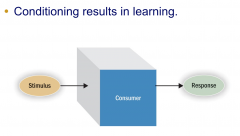![]()
![]()
![]()
Use LEFT and RIGHT arrow keys to navigate between flashcards;
Use UP and DOWN arrow keys to flip the card;
H to show hint;
A reads text to speech;
13 Cards in this Set
- Front
- Back
|
Perceptual process diagram |

|
|
|
Perceptual process |
2. Cue check: characteristics are analysed in preparation for the selection of a schema.
3. Confirmation check: the schema is selected
4. Confirmation completion: a decision is made as to what the stimulus is
Sensation refers to the immediate response of our sensory receptors (e.g. eyes, ears, nose, mouth, fingers) to such basic stimuli as light, colour and sound.
Perception is the process by which these stimuli are selected, organized and interpreted. |
|
|
Learning outcomes from operant conditioning |

|
|
|
Learning outcomes from operant conditioning |
Instrumental conditioning: the person learns to perform behaviors that produce positive outcomes and avoid those that result in negative outcomes. |
|
|
Learning outcomes diagram |

|
|
|
Components of observational learning |
Complex process as people store these informations in their memory and use it to guide their own behavior.
|
|
|
Memory systems |
|
|
|
Sensory memory |
|
|
|
Attention |
|
|
|
Short term memory |
|
|
|
Elaborative rehersal |
|
|
|
Long term memory |
|
|
|
Memory systems |
According to the information-processing perspective, there are three distinct memory systems: sensory memory, short-term memory, and long-term memory. Each plays a role in processing brand-related information, as summarized in the figure. Sensory memory stores the information we receive from our senses. This storage is temporary. If the information is retained for further processing, it passes through an attentional gate and transfers to short-term memory. Short-term memory also stores information for a limited period of time, and it has limited capacity. This system is working memory. It holds information we are currently processing. Our memories can store verbal input acoustically or semantically. We store this information by combining small pieces into larger ones in a process we call chunking. A chunk is a configuration that is familiar and the person can think about it as a unit. Long-term memory is the system that allows us to retain information for a long period of time. A cognitive process we call elaborative rehearsal allows information to move from short-term memory to long-term memory. |

